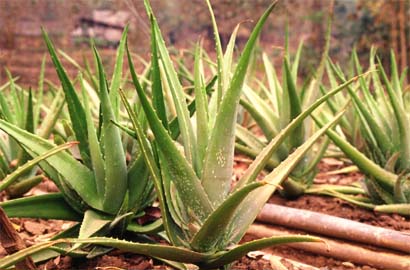ว่านหางจระเข้

ชื่อวิทยาศาสตร์ Aloe vera L.
วงศ์ Aloaceae
ชื่อพ้อง A. indica Royle, A.
barbadensis Mill.
ชื่ออื่น
ๆ
ว่านไฟไหม้ หางตะเข้ Aloe, Aloin, Barbados aloe, Crocodiles
tongue, Indian aloe, Jafferabad,
Mediteranian aloe, Star cactus,True aloe
สารออกฤทธิ์ anthraquinone
(1)
ฤทธิ์ทางเภสัชวิทยาที่เกี่ยวกับรักษาโรคผิวหนังที่เกิดจากเชื้อรา
เมื่อนำเอาว่านหางจระเข้มาบดและนำไปทำให้แห้งด้วยวิธีแช่แข็ง
ได้ผงแห้ง (I) และอีกส่วนนำเอาไปกรอง
นำสารละลายที่กรองได้ไปทำให้แห้งโดยวิธีเดียวกัน (II) ทั้ง 2 ส่วนเมื่อนำไปทดสอบกับเชื้อรา Trichophyton mentagrophytes
ซึ่งเป็นสาเหตุของโรคกลาก พบว่าผง (I) ที่ความเข้มข้น
25 มก./มล. ยับยั้งเชื้อราข้างต้นได้
และผง (II) ซึ่งมีสารซึ่งมีน้ำหนักโมเลกุลสูง 10,000 พบว่าขนาดที่ยับยั้งได้คือ 10 มก./มล. แต่ถ้านำไปผ่านความร้อนที่
100°C 30 นาที
ฤทธิ์จะหายไป
นอกจากยับยั้งแล้วยังทำให้เกิดความผิดปกติของสปอร์และ hyphae ยับยั้งการงอกของสปอร์ และการเจริญของ hyphae (2) ต่อมามีผู้ศึกษาพบว่าสารสกัดเอทานอล
ขนาด 200 มคก./มล. ได้ผลไม่ค่อยดี (3) ต่อมามีผู้พบว่าสารออกฤทธิ์ยับยั้งเชื้อ Trichophyton
mentagrophytes คือ anthraquinone (1)
นอกจากการทดสอบผลต่อ
Trichophyton mentagrophytes แล้วยังมีการศึกษาใน Aspergillus
พบว่าสารสกัดด้วยเอทานอลยับยั้ง A. niger
(3-5) ส่วนสารสกัดด้วยน้ำก็ให้ผลเช่นกัน
ส่วนสารสกัดด้วยเบนซินไม่ให้ผล (5)
แต่มีรายงานว่าสารสกัดน้ำไม่ได้ผล (6)
การทดสอบใน
yeast พบว่า aloe juice ได้ผล (7) การทดสอบผลต่อ Candida
albicans พบว่าสารสกัดด้วยเอทานอล 200 มก./มล. ผลไม่ดี (3) สารสกัดด้วยน้ำไม่ให้ผล (3, 6) สารสกัดด้วยเอทานอล 60% และทิงเจอร์ (10 ก./100 มล.) ไม่ได้ผล (8) และ aloe gel ให้ผล (9)
ดูรายละเอียดจากแก้งูสวัด เริม
1.
Ormann HP, Korting HC. Evidence
for the efficacy and safty of topical herbal drugs in dermatology. Part I.
Anti-inflammatory
agents. Phytomedicine
1994;1():161-71.
2.
Fujita K, Yamada Y, Azuma K, Hirozawa S.
Effect of leaf extracts of Aloe arborescens Mill subsp. natalensis
Berger on growth of Trichophyton
mentagrophytes. Antimicrob
Agents Chemother 1978;14(1):132-6.
3.
Mehmood Z, Ahmed I, Mohammad F, Ahmad S.
Indian medicinal plants: a potential source for anticandidal drugs. Pharmaceutical Biol 1999;37(3):237-42.
4.
Toh CA, Jung ES. Chemotaxonomical
study on aloe species.
Nonchong-Hanguk Saenghwal Kwahak Yongwwon
1985;36:151-63.
5.
Ali MI, Shalaby NM, Elgamal MH, Mousa AS.
Antifungal effects of different plant extracts and their major
components of selected aloe
species. Phytother Res
1999;13(5):401-7.
6.
Srinivasan D, Nathan S, Suresh T, Perumalsamy PL. Antimicrobial activity of certain Indian medicinal
plants used in
folkloric medicine. J
Ethnopharmacol 2001;74:217-20.
7.
Abdurakhamanova GK, Nikonova LP, Nokonov GK, Davydova RA. New sources of raw materials for
derivation of
preparations. Farmatsiya (MOSC) 1978;27(2):40-2.
8.
Caceres A, Jauregui E, Herrera D, Logemann H. Plants used in Guatemala for the treatment of dermatomucosal
infections. 1: Screenig of
38 plant extracts for anticandidal activity. J Ethnopharmacol 1991;33:277-83.
9.
Heggers JP, Pineless GR, Robson MC.
Dermaide aloe/Aloe vera gel : Comparison of antimicrobial
effects.
J Amer Med Technol 1979;41:293-4.